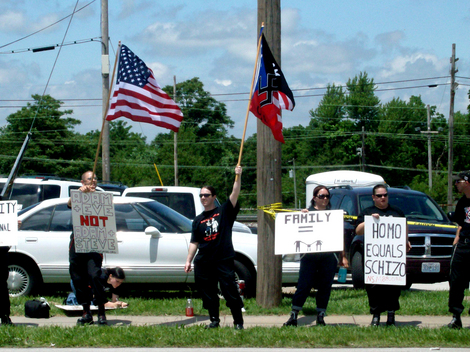The Pink Swastika authors, Scott Lively and Kevin Abrams, would have us believe that homosexuality was the driving force behind the rise of Hitler’s Third Reich. Near the beginning of chapter three of The Pink Swastika, “The Homosexual Roots of Fascism,” Lively and Abrams state this thesis:
In seeking the roots of fascism we once again find a high correlation between homosexuality and a mode of thinking which we identify with Nazism.
The chapter then traces the roots of German fascism from Plato, through Frederick the Great, and Friedrich Nietzsche – all gay by the author’s reckoning. My point is not to contest this even though one could. For instance, historians and philosophers are divided about Nietzsche’s sexuality. Reading his works, I get the feeling Nietzsche was more of a schizoid personality, meaning that he required nor wanted human tenderness. Thus, for him, asexual might be a more apt description of his behavior. However, my point here is to propose a problem for the thesis that homosexuality and fascism have a necessary causal link of some kind.
In chapter three, Lively and Abrams guess at the sexuality of many Nazi and related people but with the following figure – Thomas Mann – they are probably accurate in their assessment. About Mann, they write:
Thomas Mann’s identification with Nietzsche may also have had some thing to do with the latter’s homosexuality. Among other works, Mann is famous for a 1912 novella called Der Tod in Venedig (“Death in Venice”), in which “an aging writer risks life and reputation in his attempts to gaze on the Apollonian beauty of the 14-year-old Tadzio” (Reiter in Grolier). Homosexualist historian A.L. Rowse called this novella “the most publicized homosexual story of the century” (Rowse:212). A recently published biography, Thomas Mann: A Life, by Donald Prater, establishes the novelist’s homosexuality. A review of this book in The San Francisco Examiner (December 23, 1995) states that the book is based in part on Mann’s private diaries, which reveal a “secret homoerotic life.”
Mann was married and had six children for whom he was “a remote and some times terrifying figure.” The article reveals that two of these children, Klaus and Michael, committed suicide. Two of his children became homosexuals (Rowse:212). Mann confesses in his diary that the character Tadzio, the 14-year-old boy in “A Death in Venice,” was actually modeled after a boy on whom Mann “developed a crush while holidaying in Venice.”
Now just as the uninformed reader might think that Lively and Abrams are about to suggest Mann’s positive relationship with Hitler and fascism, the authors write:
We must be clear, however, that Mann’s contribution to Nazism, his role in popularizing Nietzsche, was unintended. Mann was personally anti-Nazi, and was persona non grata with Hitler’s government.
Lively and Abrams vastly understate the case. Mann was openly anti-Nazi and while influenced as a writer by Nietzsche, did not come to the same political or personal conclusions. On the contrary, Mann actively opposed Hitler. He used his considerable popularity with the German people in a series of radio broadcasts designed to cause common Germans to question and oppose the regime. Here is an excerpt of one of Mann’s speeches to the German people, broadcast in July, 1942:
I know well that I don’t have to warn you against exuberance now that Hitler is once again winning and has conquered Rostov, the city on the Don, which he had conquered once before. It is well known that such things do not plunge you into exuberance, that the blare of radio trumpets which accompanies the announcement is odious to you, that you are by no means overjoyed. It is not necessary to dampen your enthusiasm; rather, you have to be consoled. Not we, out here, are in need of consolation when the war looks as it does at present. If you only knew how sure we are of our cause, which to begin with, and as premise for all that is to come, is the cause of destroying Hitler! His destruction is sealed, believe me and don’t be afraid! It is a world necessity, wholly inevitable, and will be accomplished one way or another; and because it is decided, the victories of that wretch are merely bloody nonsense. You are bewildered and depressed. You are thinking: “Will he triumph after all? And shall we never get rid of him? And will the world be German, in that desperate fashion in which we are now German?” Be of good cheer! Hitler’s victory is an empty word: there is no such thing – it is not within the realm of the acceptable, permissible, thinkable. It will be prevented; rather, he himself will always prevent it, the sorry scoundrel, because of himself, simply because of his nature, because of his impossible and hopelessly deranged disposition, which does not permit him to think, want, or do anything which is not false, mendacious, condemned beforehand. One speaks of the betrayed devil. But nobody betrays the devil; he is betrayed, because of himself and to begin with. Not with Faust’s soul, the soul of humanity, will this stupid Satan go down to hell, but alone.
From Thomas Mann, Listen Germany! Twenty-five Radio Messages to the German People Over BBC by Thomas Mann. New York, 1943, pp. 102-07.
Please read the entire address on the German Documents website.
First, it is worth noting how Lively and Abrams’ devotion to their thesis leads them to treat Thomas Mann. Apparently the primary reason he is mentioned at all is to make a stronger case that Nietzsche was homosexual. Mann was a great writer, one of the best fiction writers in modern history. He was a resolute opponent of Hitler and the Nazis. He left his homeland in service of his convictions and used his fame and gifts to try to bring down Hitler. In The Pink Swastika, his personal life is disparaged and he is discounted as an apologist for Nietzsche and thus an unwitting contributor to Nazism.
Lively and Abrams thesis collapses into absurdity when one considers the vigor of Mann’s opposition to Hitler’s fascism. People of all orientations and worldviews supported and opposed Hitler. The Nazis used anyone, gay or straight, religious or not, to get to power. And once they attained power, they systematically crushed opposition both gay and straight, religious and not.
To close this post, read the closing argument offered by Mann to the German people in his July, 1942 broadcast. Note his utter contempt for the intellectual foundations of Nazism. And then recall that the speaker was attracted to the same sex.
The end is near, Germans, believe me, and be of good cheer! Just at this moment I tell it to you when once again it looks like success and victory and conquest for you. The end is near – not yours, not Germany’s. The so-called destruction of Germany is as empty a word, as non-existent a thing, as the victory of Hitler. But the end is approaching; in fact, it will come soon – the end of the repulsive system, the robber, murder, and liar state of National Socialism. An end will be put to its trashy and disgraceful philosophy and all the acts of trash and disgrace which have sprung from it. Accounts will be settled, disastrously settled, with its bigwigs, its leaders and helpers, servants and beneficiaries, its generals, diplomats, and Gestapo hyenas. Accounts will also be settled with its intellectual trail-blazers and shield-bearers, the journalists and pseudo-philosophers who licked its boots, the geopoliticians, war geographers, teachers of “Wehrwissenschaft” and race professors. Germany will be cleansed of all that ever had anything to do with the filth of Hitlerism and all that made it possible. And a freedom will be established in Germany and in the world which believes in itself, respects itself, knows how to defend itself, and which takes not only the deed but, before that, the thoughts into the control of those ideas which connect man with God.
Those inclined to accept the thesis in The Pink Swastika might complain that one bisexual opponent to Hitler is not disruptive to Lively’s proposed link between fascism and homosexuality. However, I submit that Mann’s experience is one relevant response to the idea that there is something about same-sex attraction which necessarily leads to fascist beliefs and tactics.
In addition, in future posts, I will demonstrate that at least some of the formative figures Lively and Abrams assume are homosexual (e.g., Jorg Lanz von Liebenfels and Rudolf Hoess), were not homosexual or cannot be labeled so with any certainty.
Other posts in this series:
May 28 – Scott Lively wants off SPLC hate group list
May 31 – Eliminating homosexuality: Modern Uganda and Nazi Germany
June 3 – Before The Pink Swastika
June 4 – Kevin Abrams: The side of The Pink Swastika
June 8 – A historian’s analysis of The Pink Swastika, part 1
June 9 – A historian’s analysis of The Pink Swastika, part 2
June 11 – American Nazi movement and homosexuality: How pink is their swastika?
June 15 – Nazi movement rallies against gays in Springfield, MO
June 17 – Does homosexuality lead to fascism?
June 23 – The Pink Swastika and Friedrich Nietzsche
List of posts on Uganda and The Pink Swastika

